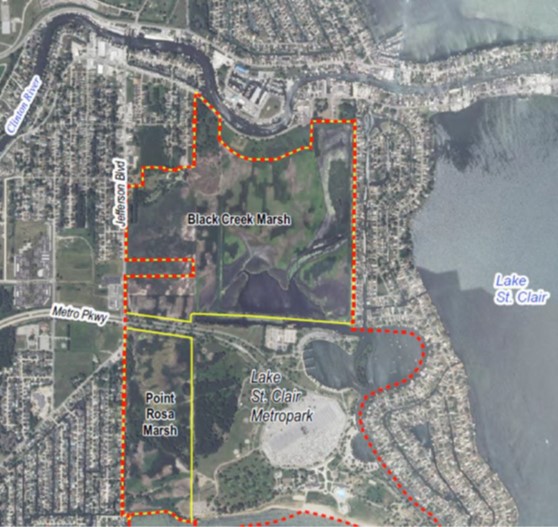Habitat Restoration in Great Lakes Areas of Concern: Clinton River
NOAA-GLC Regional Habitat Restoration Partnership
About Clinton River Habitat Restoration
The Great Lakes Commission (GLC) and the National Oceanic and Atmospheric Administration (NOAA) are leading efforts to restore several critical Great Lakes Areas of Concerns (AOCs)— the worst “toxic hotspots” in the region. In 1987, the Clinton River was designated an AOC due to environmental degradation and pollution. Funding from the Great Lakes Restoration Initiative (GLRI) was distributed by the Environmental Protection Agency to a Regional Partnership between NOAA and GLC and was allocated to the restoration of the Clinton River. Currently, significant amount of work has been taken to restore the coastal wetlands by means of dredging and removing invasive Phragmites at Black Creek Marsh, within the AOC boundary.
Black Creek Marsh Site Map
More about Clinton River Restoration
Coming soon
Benefits of Restoration
Environmental Benefits:
- Restored approximately two acres of degraded coastal wetland marsh habitat
- Enhanced fish and wildlife habitat, primarily shallow water fish spawning locations.
Economic Benefits:
- Increased recreation, tourism, and sport-fishing opportunities
Community Benefits:
- Increased water based recreation (kayaking, paddling, wildlife viewing) at Lake St. Clair Metropark
- Improved water quality and ecosystem health
- Improved fishing and fish spawning at a popular publicly accessible location.
Documents and Fact Sheets
The following fact sheets and documents provide additional information about the Clinton River project and specific elements of the project.
Fact Sheet
BUI Background
Timeline
Clinton River Habitat Restoration Database
News Coverage
- EPA awards $20 million for Clinton River watershed work | November 2015
Funding
The Clinton River Area of Concern has received over $30 million of funding from the Great Lakes Restoration Initiative (GLRI) from both the U.S. Environmental Protection Agency and the National Oceanic and Atmospheric Administration and Great Lakes Commission Regional Partnership. The GLRI is a federal program designed to protect and restore that largest system of fresh surface water in the world—the Great Lakes.
For More Information

Jill Estrada
Coastal Conservation and Habitat Restoration
Senior Program Specialist, Great Lakes Commission
734‐396‐6059 • [email protected]

Tyler Mitchell
Chief of Natural Resources and Regulatory Compliance
Huron-Clinton Metropolitan Authority
810-494-6019
[email protected]
Sign up for our e-newsletter
Get the latest Great Lakes Commission news and events in your inbox!
Sign up for our e-newsletter
Get the latest Great Lakes Commission news and events in your inbox!

